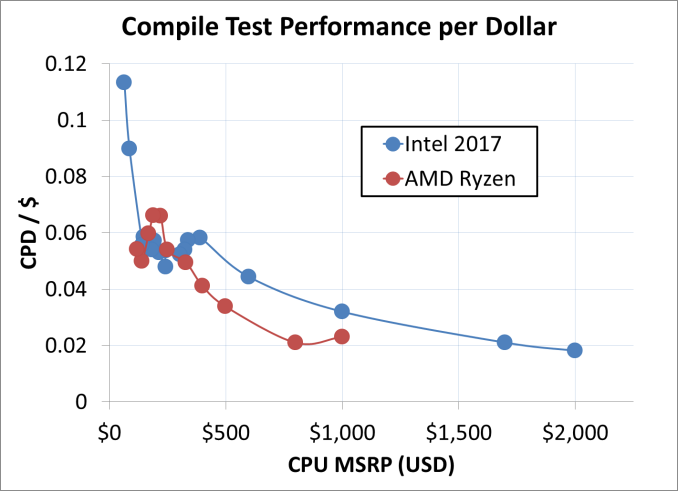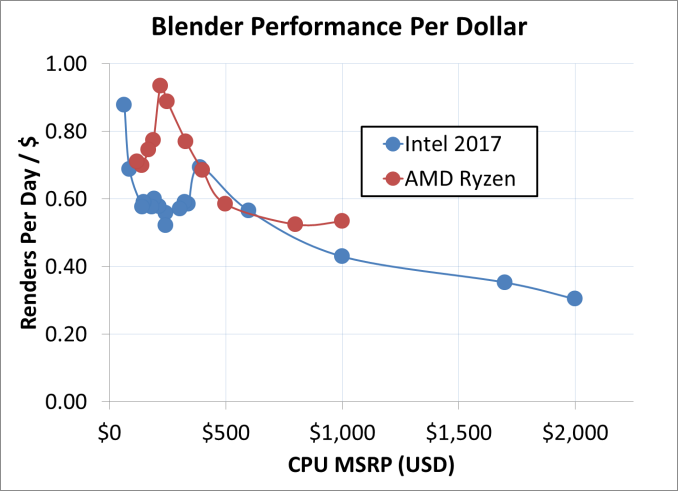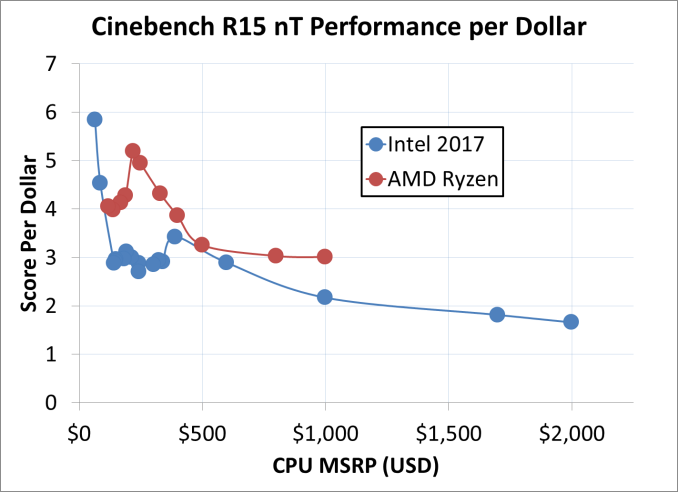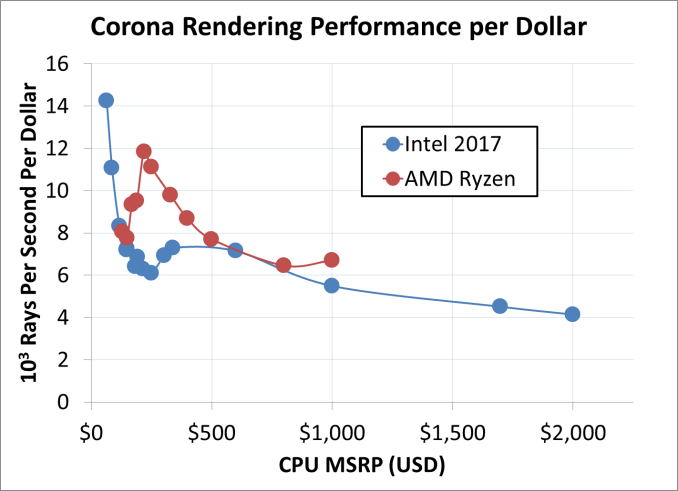The Intel Core i9-7980XE and Core i9-7960X CPU Review Part 1: Workstation
by Ian Cutress on September 25, 2017 3:01 AM ESTAnalyzing Performance Per Dollar
While measuring the performance per watt is an interesting metric, workstation processors are at the top of the stack when it comes to power consumption: the point of these processors (typically) is getting work done fast, and their users don't mind using a bit more power to get there. When it comes to designing a workstation level system for an office, the person who signs off on the project is not going to look at the performance per watt - they are going to look at the performance per dollar. Does this purchase represent the best value for the environment, and is the purchase likely to give us the best return? The following graphs attempt to answer that information, and we've chosen a varied selection including variable threaded loads.
For this analysis, we've taken all of the processors we have tested from what Intel has launched in 2017. This covers all of the consumer level Kaby Lake-S i7 and i5 parts (except T), the high-end desktop Kaby Lake-X processors, and all the high-end Skylake-X desktop parts. This is represented in the graphs in blue under the 'Intel 2017' title. From AMD, we have all eleven AMD Ryzen processors tested, under the red line.
Compile Performance Per Dollar
One of our popular benchmarks is our compile test. This takes a fixed version of Chromium v56, and runs it through the MSVC compiler with linking as per the directions given on by the Chromium developers. A typical test can run from 40 minutes to 3 hours depending on the processor, and taxes the single thread, the multi-thread and the memory performance of the system. We've seen that it does not particularly take kindly to processors with victim caches, such as Skylake-X or AMD Ryzen, with limited scaling on the code workflow. Despite the per-core performance dip from Skylake-S to Skylake-X, the top processor still has the best absolute performance. Converting our data to the number of compiles per day per dollar gives the following graph:
The cheaper end of the graph is surprisingly high, dominated by Intel's dual-core Pentium (with hyperthreading) being offered for super low prices. In the standard 'consumer' price range below $300, the mid-range Ryzen processors have a slight advantage, but, beyond the Ryzen 7 1700, Intel has the performance per dollar advantage all the way out to $2000.
Agisoft Performance Per Dollar
The Agisoft Photoscan software has been a key part of our performance testing for several years, demonstrating a true office workflow: archival purposes of taking 2D photos and converting them into 3D models. This is a computationally interesting algorithm, involving multiple single-threaded and multi-threaded stages.
Due to the single threaded elements of the algorithm, linear scaling is not observed as we ramp up through the core counts. At the mid-range consumer processor pricing, the twelve-thread Ryzen 5 processors sit above the quad-thread Core i5 parts, but beyond $330 or so, as we move into Intel's quad-core offerings and above, the performance per dollar is solely on Intel's side.
Blender Performance Per Dollar
The Blender benchmark has been an interesting debate in the last few months, with the new architectures from Intel and AMD pushing updates into the code for faster rendering. Our test takes a well used Blender release and one of the standard benchmarks (rather than anything vendor specified). Results are given in renders of this benchmark per day per dollar.
Interestingly AMD takes the peak PPD across the full range. At $999, where the competition is expected to be highest, AMD has over a 10% advantage. In the four digit range, even though the PPD of Intel's processors is lower, the absolute performance is still better. For our Blender test, this translates so a few seconds over a 2-3 minute test.
Cinebench R15 nT Performance Per Dollar
Next we move into the pure multithreaded benchmarks, which can be a significant number of workstation workloads. Here Intel might be at a disadvantage, with AMD offering more cores and more threads at each price point - Intel's IPC advantage will have to offset this in order to move ahead.
To lay some background here: AMD has been plugging Cinebench R15 nT benchmark numbers since the launch of Zen, citing better PPD. Intel's rebuttal is that in absolute performance, when you need the absolute best results, their hardware still wins.
Corona Rendering Performance Per Dollar
Ray tracing is another example of light threads taking advantage of more cores, more frequency, higher IPC and accelerated intructions with fast FP throughput. Citing back to Johan's EPYC review again, which showed AMD's good base FP performance, it will be an interesting comparison.
Similar to some of the previous graphs, the best PPD is held at Intel's low end Pentium processors - however these do not give the best overall throughput. In the mainstream price range, the Ryzen 5 1600 and 1600X are suprising peak results. In the $500-$800 range, Intel and AMD are about equal, however at $999 the Threadripper is ahead of the Core i9. Again, at the $1500+ range, Intel offers the better overall throughput, despite the lower PPD.















152 Comments
View All Comments
Gothmoth - Monday, September 25, 2017 - link
well i did not notice as much bias and other stuff when anand was still here.Spunjji - Monday, September 25, 2017 - link
Seriously..? Ever read any of the Apple product reviews? :Dandrewaggb - Monday, September 25, 2017 - link
lol, I was going to say that too. Anand had (in my opinion) a clear apple bias at the end and then went to work for them. That's not to say apple wasn't making good products or not doing interesting things - they were one of the few tech companies doing anything interesting.Notmyusualid - Tuesday, September 26, 2017 - link
+1tipoo - Tuesday, September 26, 2017 - link
I mean, imo he was pretty fair about them, he liked them and didn't say they were utter garbage because they tend not to make utter garbage. He did point out flaws fairly.flyingpants1 - Tuesday, September 26, 2017 - link
Yes that is the general consensus around here.Some of the podcasts with Anand and Brian Klug were embarrassing, they had a third guy but they would just talk over him. Brian was this really obnoxious guy who made fun of people who want removable batteries and microSD cards, he said "You got what you got!"
lmao... industry shills.. wants to save the companies 10 cents for a microSD slot, and force people to overpay for 12GB space plus data usage.. How are you supposed to shoot 4k video and keep a movie/TV database with that. 128gb microSD card is perfect. Meanwhile they add ridiculous nonsense like taptic engine and face scanning instead of making the battery a bit thicker
FreckledTrout - Monday, September 25, 2017 - link
I do because they know a disproportionate amount of their user base is tech savvy and run ad blockers with one click will en mass black block adds. Keep the adds clean and we leave the blockers off....we help each other but it is a give and take.damianrobertjones - Saturday, September 30, 2017 - link
Did you know that capitals can be your friend!ddriver - Monday, September 25, 2017 - link
Workstation without ECC... that's a bad joke right there. Or at best, some very casual workstation. But hey, if you like losing data, time and money - be my guest. Twice the memory channels, and usually all dims would be populated in a workstation scenario, that's plenty of ram to get faulty and ruin tons of potentially important data.Also, what ads? Haven't you heard of uBlock :)
"Explaining the Jump to Using HCC Silicon" - basically the only way for intel to avoid embarrassment. Which they did in a truly embarrassing way - by gutting the ECC support out of silicon that already has it.
AVX512 - all good, but it will take a lot of time before software catches up. Kudos to intel for doing the early pioneering for once.
At that price - thanks but no thanks. At that price point, you might as well skip TR and go EPYC. Performance advantages, where intel has them, are hardly worth the price premium. You also get more IO on top of not supporting a vile, greedy, anticompetitive monopoly that has held progress back for decades so it can milk it. But hey, as AT seems to hint it, you have got to buy intel not to be considered a poor peasant who can't afford it. I guess being dumb enough to not value your money is a good thing if it sends your money in intel's pocket.
nowayandnohow - Monday, September 25, 2017 - link
"Haven't you heard of uBlock :)"Haven't you heard that this site isn't free to run, and some of us support anandtech by letting them display ads?